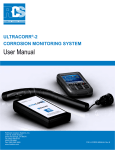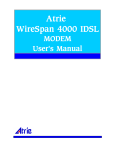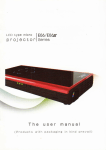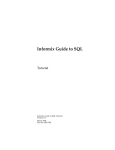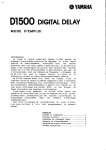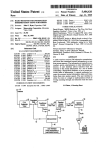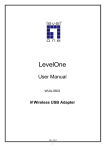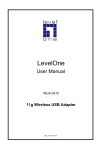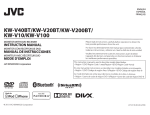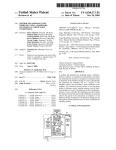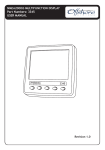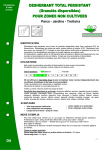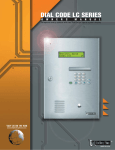Download Method and apparatus for computing device with status display
Transcript
US006311282B1 (12) United States Patent (10) Patent N0.: Nelson et al. (54) US 6,311,282 B1 (45) Date of Patent: *Oct. 30, 2001 METHOD AND APPARATUS FOR COMPUTING DEVICE WITH STATUS 5,596,628 * 5,627,882 * 1/1997 Klein ............................... .. 379/93.11 5/1997 Chien et a1. ....................... .. 455/464 DISPLAY 5,629,715 5/1997 * Zenda ....... 5,841,431 * 11/1998 Simmers . - - _ 5,867,140 (75) Inventors‘ 53111115 IA)‘ptNO:lsgIX age“ B‘ Jaeger’ Notice: 345 98 Clara, CA (US) Intel PentiumTM Processor User’s Manual, Volume 1: Pen tiumTM Processor Data Book, Chapter 14, pp. 14—1 and This patent issued on a continued pros- 14—2, 1993. ecution application ?led under 37 CFR * 1.53(d), and is subject to the tWenty year patent term provisions of 35 U.S.C. 15 4(a)(2)' cued by exammer Primary Examiner_AyaZ R_ Sheikh Assistant Examiner—Sumati LefkoWitZ Subject to any disclaimer, the term of this 5314) Attorney’ . . _ _ Agent’ Or Elrm—sklerven acPherson LLP, Norman R. Khvans U.S.C. 154(b) by 0 days. (57) (21) Appl' NO‘: 09/201,349 Filed: Rader ......... .. OTHER PUBLICATIONS patent is extended or ad]usted under 35 (22) 2 1999 345/3 .. 345/211 5,881,299 * 3/1999 Nomura et a1. .................... .. 713/3/24 (73) Assignee: Fujitsu Personal Systems, Inc., Santa (*) * . . . . .. Mom“ ABSTRACT A portable computing device' (e.'g. a notebook type computer) also includes communications features including Nov. 30, 1998 a pager receiver and a radio frequency modem Which are supported by allowing the device, under application pro Related US. Application Data (51) (52) (58) gram control, to resume operation from a suspend (sleep) state upon receipt of a paging message. Additionally, DlVlSlOIl Of application NO. 08/607,506, On Feb. 27, 1996’ now abandoned‘ Int. c1.7 ...................................................... .. G06F 1/32 us. Cl. ......................... .. 713/324; 713/323; 345/212 Field of Search ................................... .. 713/320—324; depending upon the Contents of [he message, Various application programs can be automatically launched in the main processor Under application program Control, the device can Operate in a background State With for instance the main Screen’ its backhght and the keyboard powered 345/211, 212 doWn, but With the main processor running at full speed for unattended operation. Under application program control in normal or background mode, the device can request that the unit suspend operation Without user intervention, for battery poWer savings during unattended operations. Under appli 4656 318 * 5j041:964 * 4/1987 Noyes ........................... .. 379/10204 8/1991 Cole et a1_ _____ __ 713/322 Cation Program Control’ the device can Set the State of a status message indicating a message pending or a urgent 570437721 * 8/1991 May _________ __ message Waiting. Thus reception of messages during unat (56) References Cited U-S- PATENT DOCUMENTS 5,167,024 * 11/1992 Smith et a1, 5,189,632 5,337,044 574447869 574467904 * * * * : 5,530,879 * 5,537,650 * 2/1993 8/1994 8/1995 8/1995 Paajanen et a1. Folger et a1 Stricklin et a1Belt 8t a1‘ "" " 340/825_44 713/322 tended and/or background state operation is communicated ..... .. 708/109 to the user Without resuming full operation. Additionally, in -- 340/825-44 response to a drop in output voltage from the battery Which ~~~~~ " 455/575 is the system poWer supply, transmission poWer of the RF 713/323 modem is reduced, thereby alloWing RF modem transmis glfelireitagl sions over the entire battery discharge curve. 6/1996 Crump et a1. .. 713/323 7/1996 West et a1. ......................... .. 713/324 7 Claims, 6 Drawing Sheets u_ I Ll 14 -i [FDD Pan] a a ‘_r 55 KEG Mist/hrs?“ MSABMM: A POWER SUPPLV umr/ POWER comm MPU was new Mammy Mel M Nzsmmm ‘so U.S. Patent 0a. 30, 2001 CPU Sheet 1 0f 6 10 14 / / P23S(33MHz) 16 A Intel Controller X2 " ‘ A cg??ol ; WestemDigital~DSUb15 CRT [ ll System Peripheral Controller WD7625LV DRAM 4MB (1 MX4b) h l CARD > 4/8/16MB V A i A A A 160450 160450 Power ATAj PagerlF/SMI Tablet IF Manage i A " / 2326 i / DRVA 6,0 we _ i A 68 i / D-5UB25Pin 72, 7s 4j ‘l / 7 CONNECTOR A A ii ll - 68pin Header 70/[PCMC|A x 2] [PCMClA ATA] 76 RAM Hadm l 68pin Header [Serial Port] " / A / D-SUBQpin Male CONNECTOR Cirrus Logic But. \ 66 ‘ i CL-PD6720 Digital 1i 64 IR UNIT A ii ' Pl(l>MlClLl\ Cont.| N56 ; Western 52 > 4 4? ll ll ll 4l8 3/8 5i0 <SER1> ii v v 5; Super l/O / NOAH (AS'C) / / _ IDE> WD8120LV <sER1>“\ e2 ‘LsERs>“<sEFi4>“ Female rpara||e| pon] 26pm [FDD Port] Dt ‘ aa ‘ 84 PAGEFl 88 / 96 / ii > DRAM pin x8 \ 82 JEIDA 88 WD811OLV i /lFl IF 58 34 / ;}22 A A I 622:1: ‘ 30 / ir/ WesternDigital -* l A l V A 28 A 26 llll/ System Cont. WestemDigital _ A Marla Serial MPX 1 > A Power 4i4 / 640x480 ’ l’ ii 24 viiir/ Address: 20 A A A A ‘lii 9e LCD/ > (256Kx16blv wo9oc24 A A A Address< 18 / VGA VRAM /P24S(50MHz) US 6,311,282 B1 POWER SUPPLY UNIT/ POWER CONTROL MPU FIG. 1 ii_ it A ii ii Flash Memo Mitsubishi lntel ry M38802M2 N28F010-120 ll 94 ll / MiniDlN6pin Female [Keyboard] V U.S. Patent 0111. 30, 2001 US 6,311,282 B1 Sheet 2 0f 6 P011 Address FD61H/INDEX : 32H Head/Write [Initial : FFH] 7 6 5 4 3 2 RRQ2 RBQ1 RRQO - BG OP 8 DISK 1 H81 0 H80 FIG. 2A Port Address FD61H/INDEX : 33H Read/Write [Initial : 00H] 7 6 5 4 3 2 - - BG ICON URG BL URG ON BOX B 1 0 BOX OUT BOX IN FIG. 28 Port Address FD61H/INDEX : 34H Read/Write [Initial : FEH] 7 6 5 4 3 - - - - 2 1 - 0 RADIOAK FIG. 20 Port Address FD61H/INDEX : 2DH ReadNVrite [lnitiai : FFH] 7 6 5 - 4 3 2 1 O ACPWR# LLB# LB# - FIG. 2D U.S. Patent lnitial System State On 0a. 30, 2001 Sheet 3 0f 6 Event Resulting System State Suspend/Resume button pressed Background Auto suspend Background Suspend Request (PPMI) Suspend/Resume button pressed Background Pager SMI enabled) Pager SMI disabled) Suspend, Ring Wait, or Save-to-Disk Pager SMI disabled) Save_tO_DiSk On _ Resume Time on Pager SMI Background On Resume Time On Pager SMI Suspend (pager SMI rejected) On Resume Time On Modem Ring On Pager SMl Background Suspend/Resume button pressed Ring Wait (Resume on On Background Operation disabled (PPMI) Suspend/Resume button pressed Ring Wait (Resume on Pager SMI enabled) SaVe_tO_DiSk Suspend, Ring Wait, or Suspend/Resume button pressed Suspend (Resume on Suspend, Ring Wait, or Suspend Request (PPMI) Suspend/Resume button pressed Suspend (Resume on US 6,311,282 B1 . On Resume T'me on Modern Ring On Pager SMI Suspend (pager SMI rejected) FIG. 3 U.S. Patent 0a. 30, 2001 Sheet 4 of 6 US 6,311,282 B1 ‘external subroutine for setting URGENT (ll!) display: Const UBGENT_OFF = O Const URGENT_ON = 1 Const URGENT_BL|NK = 2 Declare Sub SlC_Urgent Lib "c:\stat_lcd\iconctrl.dll" (ByVal wStatus As Integer) ‘external subroutine for setting in/out box display: Const DlBECTlON_OFF : 0 Const D|RECT|ON_|N = 1 Const DIBECT|ON_OUT = 2 Const DIBECTION_BOX : 4 Const DIRECTION__|N_BOX = 5 Const DIBECTION_OUT_BOX = 6 Const D|BECT|ON_|N_OUT_BOX = 7 ‘OFF lIN ARROW ONLY ‘OUT ARROW ONLY ‘BOX ONLY ‘IN + BOX ‘OUT +BOX ‘IN + OUT + BOX Declare Sub SlC_Direction Lib “c:\stat_lcd\iconctrl.ddl" (ByVal wStatus As Integer) ‘functions for MUXing serial port: Declare Function GetMuxStat Lib "c:\stat_lcd\iconctrl.d|l" ( ) As Integer Declare Sub SetMuxlFl Lib "c:\stat_lcd\iconctrl.dll" () Declare Sub SetMux9Pin Lib "c:\stat_lcd\iconctrl.dll" ( ) FIG. 4A U.S. Patent 0a. 30, 2001 Sheet 5 0f 6 US 6,311,282 B1 Sub Form_Load () If GetMuxStat ( ) =1 Then ‘it UAFtT MUX is now InfraRed MuxButt0n(1) .value = True ‘set IFt button to true EIsde |I;/IuxButton(O) .value = True n ‘set 9-Pin button to true InBox(0) .value = True S|C_Direction (DIRECTION_OFF) ‘initialize in/out box to off UrgStatus(O) .value = True S|C_Urgent (URGENT_OFF) ‘initialize I ! I display off End Sub Sub |nBox_C|ick (Index As Integer) If Index = 0 Then S|C_Direction (DIRECTION_OFF) ‘status icon off It Index = 1 If Index = 2 If Index = 3 If Index = 4 If Index = 5 It Index = 6 ‘in arrow on ‘out arrow on ‘box on ‘in + box on ‘out + box ()n ‘in + 0111+ box Then Then Then Then Then Then S|C_Direction S|C_Direction S|C_Direction S|C_Direction S|C_Direction S|C_Direction (DIFIECTION_IN) (DIRECTION_OUT) (DIRECTION_BOX) (DIRECTION_IN_BOX) (DIRECTION_OUT_BOX) (DIRECTION_IN_OUT_BOX) End Sub Sub MuxButton_CIiok (Index As Integer) If Index = 0 Then SetMux9Pin End If If Index=1 Then SetMuxIR End If End Sub ‘Set the UAFtT to 9-Pin External ‘Set the UART to InfraFted Sub UrgStatus_CIick (Index As Integer) FIG. 48 If Index = 2 Then S|C_Urgent (URGENLBLINK) If Index = 0 Then S|C_Urgent (URGENT_OFF) If Index = 1 Then S|C_Urgent (URGENT_ON) End Sub FIG. 4C ‘blink urgent icon ‘urgent icon off ‘urgent icon on US 6,311,282 B1 1 2 METHOD AND APPARATUS FOR COMPUTING DEVICE WITH STATUS DISPLAY full operation. This standby state typically draWs more poWer than does the suspend state. Thus there is a continuum of exemplary computer states involving increasing amounts of poWer consumption. The ?rst state is When the computer is actually off and draWing This application is a division of application Ser. No. 08/607,506, ?led Feb. 27, 1996, noW abandoned. no poWer (except perhaps for time purposes or to maintain certain data in memory); the next state is the suspend state BACKGROUND OF THE INVENTION 1. Field of the Invention This invention relates to computers and especially to a supported by the SMI; the next state is the standby state 10 operational. portable battery poWered computer Which includes commu nication features such as a Wireless modem and paging receiver. 2. Description of the Prior Art Portable computers are Well knoWn, as are personal “communicators” of the type exempli?ed by the Motorola Envoy. Such portable computing devices are invariably battery poWered. Since presently available batteries have very limited storage capabilities, it is important that such Which corresponds to the instant on feature; and the last state is the full on state in Which all computer subsystems are fully HoWever neither the instant on feature nor the manually 15 generated SMI resulting in the suspend state are suitable for a portable computer Which also includes communication features. Such communication features, While generally not part of portable computers, have been available in commu nicators. These communicators typically have included only modest computing capabilities but also include for instance a conventional Wired modem for connection to telephone 20 portable computing devices (both computers and lines, a Wireless modem for either facsimile, packet data, and/or telephone communications, and a pager receiver (an communicators) limit their poWer draW. Therefore there is knoWn a Wide range of techniques for conserving poWer in integrated pager). such battery poWered devices. These poWer conservation methods include shutting doWn portions (various 25 subsystems) of the computer When not in use, as Well as putting the computer CPU (the main processor) to “sleep” When its capabilities are not being used. Since a purpose of such communicators is to be able to receive messages from an external source at all times, typically via the pager or the Wireless modem, the commu nicator must be at least partly poWered up at all times. Thus it is maintained in a loW poWer state (not off) even When the user is not actively using it, in order to receive messages by paging or radio modem transmission. This (relatively) loW poWer state in fact requires a relatively high poWer drain because signi?cant portions of the communicator must be on Many portable computers have a main microprocessor of the type commercially available from Intel and other sup pliers called generically the “486 ” type. This microproces sor (and some others such as the Intel PENTIUMTM at all times in order to be able to receive the messages. processors) includes a suspend/resume feature and system management mode, for poWer management. Aspecial signal Hence these communicators suffer from needing frequent battery changes and/or recharges. generated for instance by a set of key strokes or pushing a special button on the computer or in some cases closing the SUMMARY top of the computer and thereby actuating a sWitch, is sent to the microprocessor. This command is called the system management interrupt (SMI) and is documented in the Intel document Pentium Processor User’s Manual Vol. 1, 1993, pp. 14-1 to 14-2. The microprocessor, upon receiving the SMI When the microprocessor is operating, executes SMI code in its SM (system management) mode, saves its current register state of operation to SRAM memory, and then enters a suspend (sleep) state in Which it is not quite off but draWs In accordance With the present invention, several improvements have been made in a combination portable computer/communicator computing device Which in one embodiment is a portable computer With an integrated paging receiver and RF and/or Wired modem. These 40 improvements increase battery life by reducing current drain, While enabling use of the communications feature at all times. The paging receiver is operatively connected to or integrated into the computing device itself so that a conven very little poWer, and hence is for all practical purposes not tional paging message can activate the computing device, operating except for checking for a subsequent SMI. for instance to alloW the radio modem to be turned on in response to the paging message and to receive information In response to subsequent receipt of an SMI, the micro processor resumes operation (executes its RSM instruction) With the same state that Was previously saved and does so 50 Which is then stored in the computing device. Thus the computing device operates at all times as a full ?edged very quickly. Hence the system management interrupt communicator, Without excessive battery drain. alloWs “toggling” betWeen the suspend and resume states, In one embodiment the computing device is maintained in a suspend state and upon receipt of the paging message, a alloWing poWer conservation Without signi?cantly impeding use of the computer, ie there is no need to reboot and reload 55 application programs. In some computers the system management interrupt is also generated by a timer; When for instance there has been no keyboard input for a particular amount of time, the SMI is generated, putting the computer into the suspend state until additional keyboard activity occurs. Another feature available in some portable computers is the so called “instant on” feature. This is someWhat different from the suspend state, in that the computer is maintained in system management interrupt (SMI) is generated by the pager interface and directed to the main microprocessor (CPU) to resume operation of the CPU. This can also result in turning on for instance of the radio modem to receive a message. That is to say, depending upon the contents of the 60 paging message, various applications programs to be executed by the CPU can be launched automatically. Thus poWer management state of the computer is controlled remotely by messages transmitted to the pager. In another feature, under application program control the a loW poWer standby state With some of the computer 65 computing device can set the state of a secondary status subsystems, eg the screen, poWered doWn. Any of the usual processor interrupts then bring the entire computer back to display (typically a small auxiliary liquid crystal display LCD) to provide an “urgent message Waiting” indicator. US 6,311,282 B1 3 4 This takes place even though the computing device is operating in a background state With the main display poWered doWn. Thus the reception of messages for instance cycles. This feature is implemented in one embodiment With via the pager or radio modem during unattended and/or background state operation can be visually indicated to the to limit the range of received signal strength at the base station receiver. This is an improvement over the prior art of user, Without resuming full operation. Thus, one operating mode of the computing device is the adjusting the output poWer only after the minimum voltage limit has already been reached. The present approach pro longs battery usefulness for both rechargeable and non no added circuitry since the packet radio protocol requires that the output poWer be adjustable in discrete steps anyWay background state, Which means that the CPU operates at full clock speed for unattended operation. In order to reduce poWer draW, various peripherals such as the main display and keyboard are turned off (poWered doWn) in the back ground state. With the computing device thus operating in background state, upon receipt of for instance a paging message by the paging receiver, the computing device can automatically turn on its other peripherals, for instance the rechargeable batteries. 1O ing those With only limited computing capabilities. BRIEF DESCRIPTION OF THE DRAWINGS 15 radio modem to receive data, Without user intervention. In summary, this approach alloWs: (1) The entire computing device to be suspended into a very loW poWer consumption mode, except for the inte to receive paging messages. (2) Upon receipt of a message sent via a conventional Wireless paging service, the computing device can be (optionally) resumed by the integrated paging receiver to FIG. 1 shoWs a block diagram of an exemplary portable computing device in accordance With the present invention. FIGS. 2A, 2B, 2C, and 2D shoW poWer control status registers in accordance With one embodiment of the present invention. FIG. 3 shoWs system operating states in accordance With grated paging receiver, Which remains poWered suf?ciently full poWer-on operational state, that is it does not require It is to be understood that the present improvements are applicable to a range of portable computing devices, includ the present invention. 25 rebooting the operating system nor reloading application programs. FIGS. 4A, 4B and 4C shoW a computer program for control of a status display in accordance With the present invention. FIG. 5 shoWs a block diagram of a circuit for reducing radio transmitter poWer output in response to a battery supply voltage drop. (3) Application programs can be launched to perform various tasks, such as poWering on the RF modem and invoking data transfer sessions, (optionally) depending on DETAILED DESCRIPTION the contents of the paging message received While the FIG. 1 shoWs the block diagram of a computing device in accordance With the present invention Which includes the features and elements of a conventional “notebook” portable computing device Was suspended. (4) Additionally, there is a “background” poWer-on state, Which operates With certain peripheral subsystems, for example the display, pen and keyboard, poWered off, so: 35 computer combined With communications capabilities including a pager receiver and a radio modem. This diagram is exemplary (and not limiting) of a system in Which the (a) the computing device can resume and operate unat tended and the application program thus invoked can re-suspend the computing device When it has com present improvements may be incorporated. This particular embodiment is a full functioned Intel 486 -type/DX2-50 notebook computer including a Mobitex radio frequency pleted execution; (b) the unattended operation of the computing device Will modem and a POCSAG-paging receiver. With reference to not be interrupted by unintentional user intervention e.g. the pen or keyboard; FIG. 1, the CPU 10 (main microprocessor) is an Intel-type (c) poWer consumption is minimiZed during unattended operation, because several of the subsystems are poW ered doWn. 486 processor, e.g. the P23S or the P24S. CPU 10 is connected to a conventional address, data and control bus 22 45 to Which is also connected a video memory (VRAM) 14 via conventional VGA controller 16, e.g. a WD90C24 Western Digital. Connected to VGA controller 16 is the LCD Which (5) Further, a separate LCD status display is poWered up even While the computing device is suspended for notifying is the main computer display having the pixel dimensions as shoWn, and the secondary display 20 connected by a D15 connector. There is also provision (not shoWn) for connec the user both of the current poWer management state of the computing device, including “background” mode, and of tion of a cathode ray tube-CRT. Also connected to the bus 22 is a conventional system conditions determined by an application program, such as an urgent message has been received. In another feature, a poWer control circuit is provided for peripheral controller 24 e.g. the Western Digital WD7625LV, a system controller 26 e.g. the Western Digital the transmitter portion of the radio (Wireless) modem in order to maintain, over the entire discharge curve of the 55 memory card 34 including additional random access memory. Connected to the portion 22A of bus 22 is an interface and poWer management integrated circuit 38 Which in this case is an ASIC (applications speci?c integrated circuit, ie a gate array) Which includes various functions. The ?rst function is based on a knoWn relationship betWeen poWer ampli?er input voltage, input current and output poWer level. The output poWer level is then set so that the input voltage Will never be less than the required minimum level. This alloWs successful radio modem transmissions throughout the dis charge curve of the battery, to compensate for the battery voltage drop as is typical of batteries during their discharge WD8110LV, 4 megabytes of dynamic RAM 28, and (connected via 88 pin connector 30) a JEIDA DRAM battery, a minimum required level of input voltage to the radio transmitter poWer ampli?er. This poWer control circuit measures the battery voltage prior to the start of transmis sion and predicts What the input voltage to the poWer ampli?er Will be When transmission starts. This prediction is a multiplexed serial port/IR interface 44 Which connects via 65 a 232C driver circuit 58 to a 9 pin connector 60 for connection to a serial port device. Port 44 also connects to an infrared unit 62 Which provides infrared serial commu nications. Thus there are tWo 16C550 UARTS in the Western US 6,311,282 B1 5 6 Digital WD8120LV chip 54; UART 44 is multiplexed by APM utiliZes more complete cooperation betWeen the oper ASIC 38 between 9 pin connector 60 and an IR unit 62. The other UART is connected to (RF) modem 82. The next element is the pager interface 46 Which is an (PPMI) interface, for example, sending “Warning” messages ating system, application programs and the BIOS APM to application programs before alloWing the system to connected to a tablet unit 64. This is for a conventional suspend (eg after a period of inactivity). Microsoft has extended this concept to their WindoWs Operating System message servicing architecture by providing WindoWs APM pen-based input. The tablet unit 64 is located physically drivers (POWER.DRV and VPOWERD.386). 16C450 interface connectable via connector 78 to a pager 84. Also provided is the 16C450 tablet interface 48 Which is under the screen 18. ApoWer management function portion 50 is described in 10 greater detail beloW. ATAportion 52 connects via a buffer 66 In accordance With the present invention, the Phoenix PPMI is extended, adding services to enable/disable Back ground Mode and the ability for an application program to to a connector 68 for PCMCIA ATA, Which is a hard disk request that the system suspend (Suspend is usually drive interface similar to the IDE interface (Integrated Drive requested by the BIOS). To alloW applications to access Electronics). Also connected to the ASIC 38 is a super I/O chip 54 eg the WD8120LV, Which also connects to the bus 22A. The next element is a PCMCIA controller 56 Which is eg the Cirrus Logic CL-PD6720 connecting also to bus 22A and connecting to PCMCIA cards (e.g. tWo such cards) via a connector 70. Also shoWn are connectors 72 and 74 con these extensions in the MS-WindoW environment, a Win 15 doWs driver is provided. A feature of APM is that, except in the case of a loW-loW battery “crisis” suspend, device drivers and application programs are noti?ed of a suspend request and may reject if 20 necting to respectively a parallel port and ?oppy disk drive port of the super I/O 54 chip. In the loWer left hand portion they are busy. If some applications accept the suspend request and others reject it, this may lead to synchroniZation problems since the system has not suspended, but some drivers or applications may think they Were suspended, since of FIG. 1, connector 76 connects the super I/O chip 54 to the they did not reject the suspend request. radio (and also Wired) modem 82. RF modem 82 may be for In a ?rst feature in accordance With the present invention, operation of this computing device is alloWed to resume from a suspend state upon receipt of a paging message. That is, under program control, the computing device resumes operation of the main processor 10 from a suspend state upon receipt of a paging message Which has been transmit instance a cellular telephone modem or other type of Well knoWn radio-based modem such as MOBITEX, ARDIS or CDPD, etc. PoWer supply unit and poWer supply microcon troller unit 96 include the actual poWer supply and the associated microcontroller Which are connected (for control purposes) to the poWer management portion 50 of the ASIC 38 and to system peripheral controller 24. In the loWer right hand portion of FIG. 1 is a Data bus to Which is connected the keyboard controller 88 Which is ted to pager 84. This program is the resume code in the BIOS, Which is executed in SMM after receipt by main processor 10 of the SMI. Additionally, depending upon the contents of the paging message, additional application pro connected to a keyboard 94 via a connector 94 and also a 35 grams can be automatically launched by main processor 10 Without user intervention. BIOS (basic input output system) ?ash memory 90 for system memory purposes. This feature is supported in the BIOS (eg the commer cially available Phoenix Technologies BIOS referred to above) stored in memory 90 as folloWs. A parameter is While in this case the RF modem 82 is a Mobitex type modem, this is not limiting but is illustrative. Similarly in this case the pager 84 is a POCSAG type paging receiver Which provides alphanumeric information of a type more extensive than a mere telephone number. This is Well knoWn and of a commercially available type and again is not limiting but is illustrative. It is to be understood that each of the various elements shoWn in FIG. 1 is of commercially available type except as described hereinafter. Moreover, the 40 45 puting devices; the device of FIG. 1 is illustrative of one application. 50 MENT BIOS Interface Speci?cation Rev. 1.1, SEP-93, Intel MS-DOS Operating System a poWer management device driver, POWEREXE, Which (optionally) uses the BIOS minimiZing poWer consumption but alloWing quick resump Thus With reference to FIG. 1, a paging message is conven tionally transmitted from an external source to the pager 84. This paging message is then sent via the pager interface 46 to the ASIC 44, and then the ASIC 44 generates an SMI Which is sent to the main processor 10 Which in response puts the computing device into the background state, Part Number 241704-001). These interfaces include a BIOS interface, Which has been implemented With extensions by Phoenix Technologies in their BIOS (Basic Input/Output System) product as the Phoenix PoWer Management Inter face (PPMI). Additionally, Microsoft provides With its described above, Wherein the main processor 10 effectively suspends execution but saves its previous state thereby tion of full operation. This is a Well knoWn feature of the 486 type of microprocessors and is not described further herein. features described hereinafter are applicable to other com As a matter of technical background, APM (Advanced PoWer Management) is a general set of interfaces de?ned by Microsoft and Intel (see ADVANCED POWER MANAGE provided in the BIOS Which either enables or disables the “resume on pager” feature. When this feature is enabled, the processor 10 resumes operation from the suspend state if a paging message is received. This suspend state is as 55 Whereby the main processor 10 operates at its full clock speed but the other peripherals (such as the display 18 and keyboard 88) are not poWered up. Note that in the background state, the auto suspend feature 60 of main processor 10 is not operative. Therefore an appli cation program running on main processor 10 in the back ground state must suspend operation of the main processor services to alloW MS-DOS and the end user limited control of system’s poWer management mode; the modes being Off, 10 using a suspend request as described beloW to avoid the Standard & Advanced. synchroniZation problems alluded to above. It is therefore possible for the PCMCIA cards (attached Standard PM (PoWer Management) mode does not rely on BIOS services and has very limited functionality (i.e. MS-DOS can put the processor into a loWer poWer mode, if the operating system and application softWare are “idling”). 65 for instance to connector 70) to be off While the main processor 10 remains operating. This is because APM-aWare application programs can accept or reject the suspend US 6,311,282 B1 7 8 request noti?cation, but other application programs, such as and may try suspend system operation during communica the PCMCIA card manager, may not be aWare of such tions. HoWever the BIOS does not alloW the main processor 10 to enter the suspend state until a particular communica rejection. Once the main processor 10 is in its background state, i.e. operating at normal clock speed, any desired application program can be automatically launched in response to a particular paging message. tion is completed and the communication module is idle. Background state is the same as the fully on state, With the exceptions that: Thus the paging message may resume execution of an 1. The main display 18 and its associated back light (not application program(s) by the main processor upon the receipt of the paging message. The resumed application program(s) are those Which Were active at the time of the previously executed suspend request. The contents of the paging message may be scanned (by one of the reactivated application programs after operation of the main processor has been resumed) and depending on the message contents, another application program(s) launched Without user inter 10 suspended. 2. The auto-suspend feature is disabled because some application programs may require more time than the auto 15 vention. For instance a particular paging message may any activity). 3. The tablet 64 (and its associated pen) and the keyboard 68 input are ignored to prevent accidental user input. Certain operations are prohibited in the background state. An application program must not disable poWer manage ring. 25 in the BIOS, Which in turn restores the state of the comput ing device to What it Was at the instant before the suspend request SMI Was generated. Control is then returned to the operating system, eg a combination of MS-DOS and Win doWs. WindoWs’ COMM driver Will service a pending ment While the computing device is in the background state. If poWer management is disabled While the computing device is in the background state, the computing device cannot be returned to the on state by pressing the suspend/ resume button or by executing keystrokes. An application program running in the background state must not issue a suspend request through the APM driver. Instead the appli cation program must use the BIOS PPMI suspend request, as described beloW. An application program running in the background state must not change the auto suspend timer regular (not system management) interrupt from the paging receiver and retrieve the received paging message, Which is then passed onto a paging application program. This paging application program can invoke another application program suspend timer alloWs. (The auto suspend timer normally puts the computing device into the suspend state if a particular time, as measured by the timer, elapses Without indicate to turn on the RF modem 82 for receipt of a longer message Which is automatically doWnloaded into the com puting device from a remote source via the RF modem 82. This occurs Without user intervention, and generally Without the user even being aWare of this happening. For instance, the computing device could be in the user’s briefcase or otherWise left unattended While these operations are occur Thus the System Management Interrupt causes the main processor to return to “full” (normal operation) processing speed and execute special system management resume code shoWn) are turned off, both to conserve poWer and to make the computing device appear to the user as if its operation is 35 depending on the contents of the paging message. Upon completion and receipt of the message, for instance via the RF modem 82, i.e. completion of execution of the through the PPMI or SETUP modules. An application pro gram running in the background state must not change the display timeout through PPMI or SETUP. Once the back ground state operation has been enabled, it stays enabled until explicitly disabled or until a PPMI suspend request is issued. application program, the main processor 10 returns to the Thus in the background state the computing device can, suspend state upon receipt of a suspend request from the under application program control, operate With the display 18, its associated backlight, and the keyboard 88 off, but application program. When the suspend request is issued, the BIOS immediately initiates the suspend procedure. This request is valid When the computing device is in the on state or in the background state, as described beloW. Even if With the main processor 10 running at full clock speed for 45 unattended operation. Another feature in accordance With the present invention background state operation is enabled, the computing device goes into the suspend procedure. supports the background state and unattended operation of the computing device. That is, the computing device can, Note hoWever that the computing device does not neces under application program control, set the state of the status sarily actually suspend operation if an APM (softWare) LCD 20 (a small LCD independent of the main screen 18) driver is connected. Rather, a suspend request noti?cation message is sent to all APM-aWare drivers (softWare modules) and to application programs Which may reject the suspend request if they are busy and do not Want to suspend Waiting indicator. Thus the reception of messages during unattended and/or background state operation is communi operation. Thus, after completion of the desired task, the computing device, under control of the application program, to provide a message in/out icon and an urgent message 55 returns to the suspend state, i.e. is asleep, aWaiting the next need to resume operation. The actual return to the suspend state is performed by the BIOS and the suspend feature of the main processor. Thus the availability of the background state operation supports the resume-on pager feature. Again, this feature is enabled or disabled depending on a BIOS parameter. The computing device is intended to send and receive various cated to the user Without resuming operation of the com puting device. This is because the status LCD 20 is in operation even When the main processor 10 is in the suspend state. That is to say, this information displayed by the LCD 20 is provided from the poWer management microccontrol ler 96 and ASIC 44 rather than from the main processor 10. FIGS. 2A, 2B, 2C and 2D shoW various located registers in ASIC 44 to support the above described poWer control features. FIG. 2A shoWs a host command/status register Where the bits have the folloWing signi?cance: data Without user intervention as described above. Thus it is 65 possible that the user may not even notice that the commu Bit 7—5: RRQZ-O (Radio Request) nication module (pager 84/RF modem 82) is in operation, module). Request code for poWer source of RF modem (radio US 6,311,282 B1 10 -continued RRQ 2-0 Request Bit 2: LLB# (Low Low Battery) [0, 0, 0]: Reset of acknowledge [1, 1, 0]—[1, 1, 1]: Reserved [0, 0, 1]: Reserved This bit shows the status of the main battery of the computing device. 0: Low low battery (need to stop operation) [0, 1, 0]: Power source for COM. Module ON 1: none [0, 1, 1]: Reserved [1, 0, 0]: Reserved Bit 1: LB# (Low Battery) This bit also shows the status ot main battery. [1, 0, 1]: Power source for COM. Module OFF Bit 3: BGiOP (Back Ground Operation) 0: Low battery (need to pay attention) 10 This bit informs of the background state to Power MPU96. Whenever the computing device enters into the background state, this bit is set. FIG. 3 shows (in a tabular form) a state diagram indicat ing state transitions where the background state operation is 0: Background Mode Disabled 1: Background Mode Enabled Bit 2: SiDISK (Save to Disk Mode) This bit informs of the setting of system set-up 15 menu to Power MPU 96. Change of the system setting is re?ected in this bit. 0: Save to Disk 1: Memory Suspend “Background”, “Waiting” or “Suspend”. up) state, (2) the background operation state, (3) the susp end 20 state, and (4) the ring wait state. The state transitions are determined by the BIOS. While the corresponding BIOS code is not shown here, it is readily written by one of ordinary skill in the art in light of this disclosure. Every change of the state is re?ected in this bit. [HS1, 0] = [0, 0] Suspend [0, 1]: RI Waiting As described above, one feature which supports the [1, 0]: Background operation [1, 1]; ON enabled. The “Suspend/Resume button” is a user-controlled button on the computing device allowing the user to toggle between these two states. “Ring Wait” is the state of await ing a Modern Ring. This state diagram makes clear the transitions between the states of (1) being on (fully powered Bit 1-0: HSI-0 (Host Status) These bits inform of the system state, eg “ON”, 1: none 25 background and suspend states is the provision of the message in/out and the urgent message waiting via the status display 20. The corresponding urgent status icon can have The icon display register controls the urgent message any one of three values, i.e. off, on, or blink. The in/out feature and as shown in FIG. 2B has bits having the message box status i con can have any one of the values off, following signi?cance: 30 in arrow only on, out arrow only on, message box only on, in arrow in box on, out arrow in box on, and in and out and in box on. Thus the status display 20 shows these icons even when the computing device itself is in the suspended state. Hence, an application program running in the background Bit 5: BG ICON (Background Operation Icon) This bit turns on or off the icon on status display 20 indicating “Background operation”. state can warn the user of an urgent message by using the 35 0; ICON oFF 1; ICON ON (Display) status display in response for instance to a received paging message which wakes the computer from the suspended state and puts it in the background state. The urgent message Bit 4-5: URGiXX (Urgent Icon) This bit controls the icon of “URGENT”. Bit 4: URGiBL (Urgent Icon blink) icon can ?ash on and off to better attract attention of the user. 0: No blink 1: Blink This indicates a received paging message for instance or Bit 3: URGiON (Urgent Icon ON/OFF) 0: ICON OFF 1: ICON ON 40 This bit controls the icon of “IN/OUT BOX”. Bit 2: BOXiB (“BOX” Icon of IN/OUT BOX ON/OFF) 0; ICON oFF 1; ICON ON (Display) Bit 1: BOXiOUT (“OUT” Icon of IN/OUT BOX ON/OFF) 0; ICON oFF 1; ICON ON (Display) initial receipt of a paging message followed by, after the RF modem is turned on, a longer message received via the RF modem. Thus an application program running in the back ground state may turn on the urgent message icon to indicate Bit 2-0: BOXiXX (IN/OUT BOX Icon) 45 Bit 0: BOXiIN (“IN” Icon of IN/OUT BOX ON/OFF) 0; ICON oFF 1; ICON ON (Display) receipt of an urgent message and then again suspend opera tion of the computing device while the urgent message icon continues to be displayed and/or to ?ash. That is to say, this status display 20 continues to provide an indicator even in the suspend state of the computing device. This status display 20 is eg a re?ective (not backlit) LCD to minimize The power MPU acknowledge register of FIG. 2C con trols the power source switching for the radio modem 82 and has the single bit as follows: power drain so that it at least a portion of it is powered on response against “Radio RQ”. 0: none (or Nack) 1: Power source switching completed. at all times while drawing minimum power. FIGS. 4A, 4B and 4C show a exemplary (application) computer program for controlling the urgent message indi cator icon. FIG. 4A shows this program’s general declara tions and FIGS. 4B and 4C show the actual program. The software module ICON CTRL.DLL receives passed param eters as Word values. Because the language in which this The power MPU status register of FIG. 2D has the meaning as follows: program is written, Visual Basic, passes parameters by reference, the “ByVal”, keyword is required in the declara Bit 0: RADIOAK (Radio Acknowledge) When the power source switching requested by “Radio RQ” is completed, this bit becomes “1”. Nack (negative acknowledge) is informed by more than 500 ms of no 55 60 tion in FIG. 4B to pass the correct parameters. Similarly, the value “As Integer” ensures that the value passed is a 16 bit (Word) value. Bit 3: ACPWR (AC Power Source) Upon loading this program, both status display support This bit shows the status of external power source services are initialized to Off, to avoid synchronization input. 0: External power source inputting 1: No external power source input 65 problems. The current assignment of the UART 84 is determined, and the appropriate option button set to true to display that assignment. US 6,311,282 B1 11 12 Another feature in accordance With the present invention, as described above, is control of the output poWer of the RF modem 82 in response to diminished battery voltage. A block diagram of a circuit to accomplish this is shoWn in Battery Charge Lvl. Battery Voltage Power Output Power Amp Input Volt PoWer Amp Current Full 90% 75% 60% 45% 30% 15% 0% 7.4 Volts 7.25 7.0 6.75 6.35 6.0 5.85 5.7 3.0 Watts 3.0 2.9 2.5 2.1 1.7 1.4 1.2 7.0 Volts 6.8 6.55 6.1 5.7 5.4 5.4 5.4 1 5 Amps 1.6 1.7 1.8 1.9 1.8 1.4 1.2 FIG. 5. The circuit of FIG. 5 shoWs relevant portions of RF modem 82; the remaining portions are conventional. The data from super I/O chip 54 to be transmitted is coupled to poWer ampli?er 102, Which in turn has its output terminal 10 coupled to radio antenna 104. Battery 106 (the battery of the device shoWn in FIG. 1) has a conventional variable output battery voltage, and is coupled through circuit resistance 108 to supply drive current to poWer ampli?er 102, thereby providing a poWer ampli?er input voltage Which is measured and converted by analog to digital converter 110, the digital 15 are intended to fall Within the scope of the appended claims. Also, it is to be understood that the various features output terminal of Which is connected to an input terminal of microccontroller 112 (This microccontroller is part of block 82 of FIG. 1.). Microcontroller 112 provides a (digital) poWer out level reference value Which is converted to an analog signal by digital to analog converter 116 to drive the positive terminal of error ampli?er 120, the inverting terminal of Which is connected by a feedback loop to the antenna104 by poWer measuring circuit 124. Error ampli?er 120 provides a poWer level setting to the control (gain) terminal of poWer ampli?er 102. It is characteristic of the poWer ampli?er 102 used in this described herein may in at least some cases be independent 20 operating the computing device in a suspend state Wherein 30 decreases, the poWer ampli?er current increases, in an attempt to maintain a constant PoWer Out as established by battery 106 discharges during transmitter operation. Since 40 maintains the required minimum poWer ampli?er input voltage by adjusting the poWer ampli?er poWer level setting. full discharge cycle of the battery 108, although at reduced 45 poWer ampli?er input voltage is equal to the battery voltage. When the poWer ampli?er 102 is transmitting, hoWever, the poWer ampli?er input voltage is loWer than the battery voltage due to the voltage drop across the circuit resistance 108. The microccontroller 112 samples the input voltage before the poWer ampli?er 102 begins transmitting and then 50 requires that the transmitter poWer be adjusted in any case to compensate for changes in receiver signal strength. Exem plary poWer level settings controlled by a conventional program resident in microccontroller 112 are shoWn in the folloWing table: display Which is a liquid crystal display coupled to the main processor, and further comprising: means for operating the computing device in a suspend state Wherein the poWer management circuit and at least a portion of the status display are poWered up, and the main processor and the main display are off; puting device from an external source; and means for poWering up the main processor in response to 55 across the circuit resistance 108 caused by the poWer ampli ?er current Will provide not less than the minimum required eg 5.4 volts input voltage to the poWer ampli?er 102. The advantage of this approach is that compensation for variations in battery voltage is accomplished Without adding additional circuitry, since the packet radio netWork protocol at the computing device, after the step of resuming the normal operation of the main processor. 2. The method of claim 1, further comprising the step of not poWering up the main display When the main processor means for receiving a message transmitted to the com adjusts the poWer out level reference to a value Which ensures that the battery voltage minus the voltage drop response to receipt of the message; and indicating on the status display a reception of the message resumes normal operation. 3. A computing device having a main processor, and a poWer management circuit, a main display and a status This alloWs operation of the poWer ampli?er 102 over the output poWer levels. When the poWer ampli?er 102 is not transmitting, then the the poWer management circuit and at least a portion of the status display are poWered up, and the main pro cessor and main display are off; transmitting a message to the computing device from an eXternal source; resuming normal operation of the main processor in 35 voltage of eg 5.4 volts, so it is necessary to ensure that this minimum input voltage is exceeded or maintained as the the relationship betWeen poWer ampli?er current and PoWer Out is knoWn and predictable, the circuit shoWn in FIG. 5 of one another, and it is contemplated that a computing device may include only some of these features. We claim: 1. A method of operating a computing device having a main processor, a poWer management circuit, a main display and a status display Which is a liquid crystal display, comprising the steps of: computing device that, as the poWer ampli?er input voltage the “PoWer Level Setting” input to the poWer ampli?er 102. The poWer ampli?er 102 Will not operate properly beloW a This disclosure is illustrative and not limiting; further modi?cations Will be apparent in light of this disclosure and receipt of the message, and after the main processor is poWered up, indicating on the status display a reception of the message at the computing device. 4. The computing device of claim 3, further comprising means for not poWering up the main display When the main 60 processor is poWered up. 5. A method of operating a computing device having a main processor, a poWer management circuit, a main display and a status display, comprising: operating the computing device in a suspend state Wherein the poWer management circuit and at least a portion of the status display are poWered up, and the main pro cessor and main display are off; US 6,311,282 B1 14 13 means for operating the computing device in a suspend state Wherein the poWer management circuit and at least a portion of the status display are poWered, and the main processor and the main display are off; transmitting a message to the computing device from an external source; resuming normal operation of the main processor in response to receipt of the message; indicating on the status display a reception of the message at the computing device, after the step of resuming the normal operation of the main processor; and continuing to display a message Waiting indicator during the suspend state of the computing device. 6. The method of claim 5, furthercomprising not poWering means for receiving a message transmitted to the com puting device from an external source; means for poWering up the main processor in response to 10 up the main display When the main processor resumes normal operation from the suspend state. 7. A computing device having a main processor, and a poWer management circuit, a main display and a status display coupled to the main processor, and further compris mg: 15 receipt of the message, and after the main processor is poWered up, indicating on the status display a reception of the message at the computing device; and Wherein a message Waiting indicator is displayed during the suspend state of the computing device.















![[54] W, rm-pg`vzvlsggéggllslswnolq MONITOR OTHER](http://vs1.manualzilla.com/store/data/005697201_1-5cf72edac23b396dc325f3c508f97781-150x150.png)


